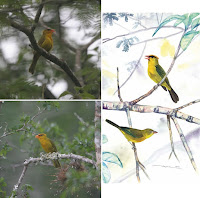 |
| Heliothraupis oneilli Lane, Justiniano, Terrill, Rheindt, Klicka, Rosenberg, Schmitt & Burns, 2021 |
Abstract
We describe a colorful and distinctive new species of tanager from the lower slopes of the Andes of southeastern Peru and western Bolivia. The species was first noted from southeastern Peru in 2000, but little of its natural history was uncovered until the 2011 discovery of a breeding population in deciduous forest in an intermontane valley, the Machariapo valley, in Bolivia. This species appears to be an intratropical migrant, breeding in deciduous forest during the rainy season (November–March) and spending the dry season dispersed along the lower slopes of the Andes, apparently favoring Guadua bamboo-dominated habitats in both seasons. Phylogenetic evidence suggests this tanager is embedded within a clade of thraupids that includes Ramphocelus, Coryphospingus, Loriotus, Tachyphonus, and related genera in the subfamily Tachyphoninae. Within this subfamily, the new species falls in a clade with two monotypic genera, Eucometis penicillata (Gray-headed Tanager) and Trichothraupis melanops (Black-goggled Tanager). There is strong support for a sister relationship between the new tanager and T. melanops, but because all three species in this clade are highly distinctive phenotypically, we propose erecting a new genus and species name for the new tanager.
Daniel F. Lane, Miguel Angel Aponte Justiniano, Ryan S. Terrill, Frank E. Rheindt, Luke B. Klicka, Gary H. Rosenberg, C. Jonathan Schmitt and Kevin J. Burns. 2021. A New Genus and Species of Tanager (Passeriformes, Thraupidae) from the lower Yungas of western Bolivia and southern Peru. Ornithology. ukab059. DOI: 10.1093/ornithology/ukab059
RESUMEN: Describimos una nueva especie de tangara, colorida y distintiva, de las colinas bajas de los Andes del sureste de Perú y del oeste de Bolivia. La especie fue registrada por primera vez en el sureste peruano en el año 2000, pero poco de su historia natural fue develada hasta el año 2011, cuando se descubrió de una población reproductiva en bosques caducifolios en un valle intermontano (valle del Machariapo) en Bolivia. Parece que esta especie es un migrante intratropical, que se reproduce en bosques caducifolios durante la temporada de lluvias (noviembre-marzo) y pasa la temporada seca, dispersa a lo largo de las colinas bajas de los Andes, aparentemente prefiriendo los hábitats dominados por el bambú Guadua, en ambas estaciones. La evidencia filogenética sugiere que esta tangara está dentro de un clado de tráupidos que incluye a Ramphocelus, Coryphospingus, Loriotus, Tachyphonus y géneros relacionados en la subfamilia Tachyphoninae. Dentro de esta subfamilia, la nueva especie pertenece a un clado con dos géneros monotípicos, Eucometis penicillata y Trichothraupis melanops. Existe un fuerte soporte para una relación hermana entre esta nueva tangara y T. melanops, pero debido a que las tres especies dentro de este clado son fenotípicamente muy diferentes, proponemos erigir un nuevo género y nombre de especie para la nueva tangara.








